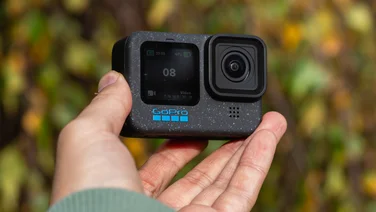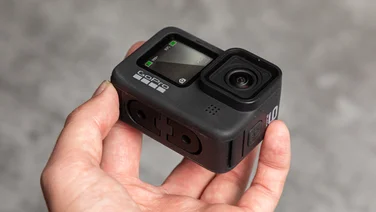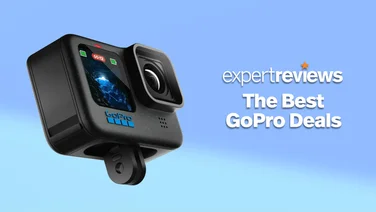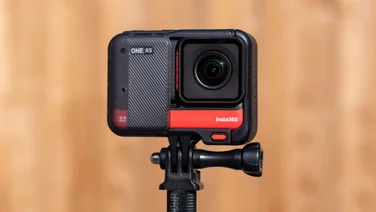To help us provide you with free impartial advice, we may earn a commission if you buy through links on our site. Learn more














- Absolutely tiny
- Impressive stabilisation
- Decent video quality
- Usability issues
- Flaky connectivity
- Short battery life
The Insta360 GO is an exciting product and breaks ground in a number of different areas. It’s possibly the smallest, lightest action camera on the market; it weighs a mere 20g and can shoot top quality 1080p video, time-lapses and slow-motion clips, and it can be mounted pretty much anywhere.
Despite its size, it’s also a highly capable device with built-in video stabilisation, horizon-levelling and software that can automatically create and edit clips together for you in time to music.
READ NEXT: Insta360’s latest action camera is modular
Insta360 Go review: What you need to know
The Insta360 Go is absolutely tiny – thinner and shorter than my thumb – and it weighs as much as five cubes of sugar. With a magnetic rear and a range of clever mounts supplied in the box, you can mount the camera in all sorts of places and barely be aware it’s there.
It can’t capture at 4K, more’s the pity, but it can create 1080p video clips at 25fps fully stabilised – via Insta360’s FlowState tech – and there are a number of other handy modes. You can shoot static timelapse shots with it, or hyperlapse clips. It even records in slow motion or at preset intervals. Naturally, you can also capture photographs with it as well, at 6.5 megapixels in resolution.
This isn’t an action camera in the traditional sense of the word, however, as it can only record short clips, either 15, 30 or 60 seconds in length. The idea is to take the faff out of action camera use so you can concentrate on enjoying whatever you’re doing at the time.
Insta360 Go review: Price and competition
Given this approach, it’s hard to compare and contrast the Insta360 Go with other cameras directly. It isn’t exactly cheap, either, costing £210. In other words, you’re paying a significant premium for the tiny size and convenient magnetic mounting options.
If you’re interested in a water-resistant, rugged, wearable camera, pretty much your main choices at this price are all going to be GoPro-style cameras. You can pick up a GoPro Hero 7 Silver, for instance, with a 32GB storage card thrown in for £179. That’s nowhere near as small and light as the Insta360 GO but it can record in 4K and doesn’t have stringent limits on video clip length.
You can grab yourself a DJI Osmo Action, if you step up in price to around £280. Again, this is a GoPro-style camera with the traditional peg-and-prongs mounting system, which can record higher-quality 4K video, fully stabilised, at any clip length you like. In short, you’re going to have to really buy into the Insta360 GO’s way of doing things to justify spending this much on one.
Insta360 Go review: Design and features
And the Insta360 GO’s way of doing things is very different indeed. This starts with its tiny size (20g) and magnetic mounting system, which lends itself to some interesting mounting options.
Handily, a number of these are included in the box, my favourite of which is the necklace mount. This has a metal disc attached to an adjustable lanyard that you wear beneath your clothes and stick the camera to on the outside. It doesn’t work too well with thick coats and jumpers but for T-shirts and shirts it’s a great casual mounting option and attaches pretty sturdily, too.
There are also a couple of adhesive mounts included – one a mini stand, the other a rubberised plate – and a bag-strap clip with a rubber shim that’s best used if you want to wear the camera for cycling or running or some other more vigorous activity.














The other main item in the box, aside from the camera itself, is the Insta360’s charging case. This is used to top-up the tiny battery inside the camera – just snap it in and it starts to charge – and to connect the camera to your phone for transferring images and video. There’s no Wi-Fi connection as with a GoPro or Insta360’s more expensive cameras; instead, you plug the thing in physically, either via the stubby lightning connector on the base of the case for iPhone, or via a microUSB socket on the side for Android handsets.
That might sound neat but, in practice, it turns out to be a bit awkward to use. The first problem is that the connector (at least for iPhone connectivity) sits flush against the base of your phone, so you have to remove your handset from its case to connect it. The second is that the rubber bung provided to protect the connector isn’t tethered to the case in any way. That means you’re absolutely going to lose it in no time flat.
The final irritation is that, in order to transfer images to your phone and the app, the case has to have some charge available to it. If it’s drained (and there’s no way to stop the camera from drawing a charge when it’s attached) you’ll have to wait until you can plug it in to empty the camera’s 8GB of onboard storage and begin working with your files. Even then, it doesn’t work particularly reliably; sometimes the app picks up the case, sometimes when I plugged it in it didn’t work at all.














Insta360 GO review: Control, filming modes and app
To actually start using the camera, you have a couple of options. Either press the button on the rear – with the camera mounted, you simply squeeze the camera – or connect to the camera via Bluetooth and control the Insta360 remotely via the app on your phone. Video clips can be 15, 30 or 60 seconds long, choices you can make from the app’s Settings menu.
The GO allows you to do more than shoot straight video clips, however. You can also shoot clips at set intervals throughout the day; capture smooth hyperlapse videos for recording durations ranging from 30 seconds to 15 minutes; or shoot 15- or 30-second slow-motion clips.
Each mode can be assigned to the squeezy button so you don’t have to delve into the app every time you want to capture something and you can have different shot types assigned to double and triple presses. In real-world use, however, it doesn’t work quite as well as it should and that’s mainly because the camera needs to be switched on with a long press of the button before it’s able to recognise double and triple presses. Took me a while to work that one out.














One nice touch, however, is that the camera will vibrate at you when it recognises a button press. It will then buzz once again when your clip finishes recording.
The app is where you first go to connect to and set up the camera but it’s also where you’ll spend most of your time editing. It’s organised into three sections: Album, where all your clips and photos are stored; Explore, where you can view and get inspiration from other people’s work; and Stories, where you create your own social video masterpieces.
Within the Stories section, you can either choose to select Themes, where the software attempts to automatically create an edit to a musical backing; and My Stories, which lets you edit your clips together yourself. I think the names of these two options is a touch confusing but once you’ve figured out what to do they work surprisingly well. The latter, in particular, gives you oodles of control over clip length, transitions, speed, filters and image tuning.
In the editing screen, there’s also the option to overlay text and it’s even possible to reframe your video to a certain extent. This is thanks to the fact that the camera captures at 2,720 x 2,720, and the app only exports a small portion of the frame.














Insta360 Go review: Image quality
As I mentioned at the top of the review, the Insta360 GO can’t record 4K. At 1080p its output frame rate is limited to 30fps at a bit rate of 30Mbits/sec. That doesn’t sound great but what’s truly impressive about this little camera is that it employs Insta360’s uncannily effective FlowState electronic image stabilisation by default. This produces video so smooth – in regular and hyperlapse modes – that it looks almost like it was shot on a gimbal.
The trick to this is that the resolution of the sensor is actually a lot larger than 1080p (2,720 x 2,720), thus allowing the extra resolution around the edges of the frame to be used as a buffer. In conjunction with the six-axis motion sensor inside the camera, this keeps the 1080p frame completely steady.
In fact, just as the GoPro Max 360 camera does, you don’t have to worry about the orientation of the Insta360 GO at all – FlowState stabilisation automatically horizon-levels the footage, so it doesn’t matter that the camera is mounted horizontally, vertically or somewhere in between, footage always comes out dead straight.
It’s only when the light dims that the stabilisation begins to struggle, adding a visible shimmer to footage whenever you take a step. Otherwise, it’s remarkably sure-footed. Video quality is equally impressive. I’d like the option to shoot at 60fps or 50fps but within its limitations both the image and, surprisingly, the audio quality via the tiny pinhole microphone on top of the camera, are solid.
Colours are nice and punchy, exposure normally well-judged and its quality is decent. It can’t rival a GoPro Hero 8 Black or a Hero 7 Black or the DJI Osmo action, and as with all cameras of this ilk, quality suffers when the light is low, but it’s still acceptably good. In the scene below, grabbed from a side-by-side clip shot at the same time on a GoPro Hero 8 Black, the Insta360 Go clearly struggles with the extremes of bright and dark in the scene, blowing out the highlights noticeably. The footage isn’t as clean as it is coming out of the GoPro, either, exhibiting lots of speckly compression artifacts.

One other issue I found while testing was that, while recording hyperlapse clips, the camera didn’t adapt its colour balance automatically when transitioning from inside, under artificial lighting, to outside. If you start recording inside and then walk out your front door, chances are that the outdoors part of your clip is going to look decidedly odd.
Still, generally speaking, footage is far from bad and is fine for mucking about with and recording moments when you’re on holiday and don’t want to fuss with a camera too much. Plus, the auto “Themes” editor can come up with some impressive-looking stuff that’s great for quick social uploads and the like.
Insta360 GO review: Verdict
The Insta360 GO is certainly strikingly different. It’s an incredibly small camera and, for its size, it produces great quality video. I love the magnetic mounting system and also that the stabilisation system works so well. The app is capable of surprisingly decent results and the auto-editing system is fun to play around with, too.
However, it’s far from perfect and has numerous usability and connectivity flaws that prevent me from giving it the solid thumbs up. I’m also unconvinced that it needs the restriction of only being able to shoot short clips. If you think you want an action camera, is it really all that much faff to opt for a more traditional camera instead and a few mounts for it instead?
Ultimately, the Insta360 GO is an interesting product but it feels like it could do with a Pro mode and a few tweaks to the firmware to unlock its true potential.







